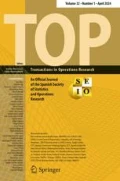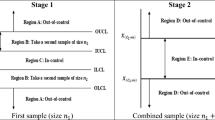Summary
Linear Porgramming models for stochastic planning problems and a methodology for solving them are proposed. A production planning problem with uncertainty in demand is used as a test case, but the methodology presented here is applicable to other types of problems as well. In these models, uncertainty in demand is characterized via scenarios. Solutions are obtained for each scenario and then these individual scenario solutions are aggregated to yield an implementable non-anticipative policy. Such an approach makes it possible to model correlated and nonstationary demand as well as a variety of recourse decision types.
For computational purposes, two alternative representations are proposed. A compact approach that is suitable for the Simplex method and a splitting variable approach that is suitable for the Interior Point Methods. A crash procedure that generates an advanced starting solution for the Simplex method is developed. Computational results are reported with both the representations. Although some of the models presented here are very large (over 25000 constraints and 75000 variables), our computational experience with these problems is quite encouraging.
Similar content being viewed by others
References
Alvarez, M., L.F. Escudero, J.L. de la Fuente, C. García and F.J. Prieto (1994). Network planning under uncertainty with an application to hydropower generation,TOP 2, 25–58.
Birge, J.B. (1985). Decomposition and Partitioning Methods for Multistage Stochastic Linear Programs,Operations Research 33, 989–1007.
Birge, J.B. (1988). AnL-Shaped method computer code for multi-stage stochastic linear programs, in: Y. Ermoliev and R.J.-B. Wets (eds.), Numerical techniques for stochastic optimization (Springer-Verlag, Berlin), 255–266.
Bitran, G. and H. Yanesse (1984). Deterministic approximations to stochastic production planning problems,Operations Research 32, 999–1018.
Bitran, G. and S. Sarkar (1988). On upper bounds of sequential stochastic production planning problems,European J. of Operational Research 34, 191–207.
Bjornestad, S., A. Hallfjord and K.O. Joernsten (1989). Discrete Optimization under uncertainty: The scenario and policy aggregation technique, working paper 89/06, Chr. Michelson Institute, Fantogt, Norway.
Dantzig, G.B. and P.W. Glynn (1990). Parallel processors for planning under uncertainty,Annals of Operations Research 22, 1–21.
Dembo, R.S. (1991). Scenario immunization, in: S.A. Zenios (ed.) Financial optimization (Cambridge University Press, Cambridge, USA).
Dembo, R.S. and A.J. King (1991). Tracking models and the optimal regret distribution in asset allocation, research report RC-17150, IBM T.J. Watson Research Center, Yorktown Heights, NY.
Dempster, M.A.H. (1988). On Stochastic Programming II: Dynamic problems under risk,Stochastics 25, 15–42.
Ermoliev, Y. and R.J.-B. Wets (eds.) (1988). Numerical techniques for stochastic optimization (Springer-Verlag, Berlin) 255–266.
Escudero, L.F. and P.V. Kamesan (1993). MRP modelling via scenarios, in: T.A. Ciriani and R.C. Leachman (eds.), Optimization in industry (John Wiley, London) 101–111.
Escudero, L.F., P.V. Kamesan, A. King and R.J.-B. Wets (1993). Production planning via scenario modelling,Annals of Operations Research 43, 311–355.
Escudero, L.F., J.L. de la Fuente, C. García and F.J. Prieto (1994). On solving multistage stochastic linear networks,Mathematical Programming (submitted for publciation).
Eppen, G.D., R.K. Martin and L. Schrage (1989). A scenario approach to capacity planning,Operations Research 37, 517–527.
Forrest, J.J. and J.A. Tomlin (1992). Implementing Interior Point Linear Programming methods in the Optimization Subroutine Library,IBM Systems Journal 31, 26–38.
Gassmann, H.I. MSLiP (1990): A computer code for the multistage stochastic linear programming problem,Mathematical Programming 47, 407–423.
Guignard, M. and S. Kim (1982). Lagrangian Decomposition: A model yielding stronger Lagrangian bounds,Mathematical Programming 39, 215–228.
IBM, OSL (1990). Optimization Subroutine Library, Guide and Reference, SC23-0519.
Infanger, G. (1989). Monte Carlo (Importance) Sampling within a Benders decomposition algorithm for stochastic linear programs, technical report SOL. 89-13, Systems Optimization Laboratory, Stanford University, Stanford, CA.
Infanger, G. (1994). Planning under uncertainty (Boyd & Fraser publishing, Danvers, MA).
Joernsten, K.O., M. Nasberg and P.A. Smeds (1985). Variable Splitting: A new Lagrangian relaxation approach to some mathematical programming models, report LITH-MAT-R-85-04, Linkoping Institute of Technology, Linkoping, Sweden.
Lusting, I.J., R.E. Marsten and D.F. Shanno (1992). On implementing Mehrotra's Predictor-Corrector Interior Point Method for Linear Programming,SIAM J. of Optimization 2, 435–449.
Lusting, I.J., J.M. Mulvey and T.J. Carpenter (1991). Formulating twostage stochastic programs for interior point methods,Operations Research 39, 757–769.
Meggido, N. (1991). On finding Primal and Dual optimal bases,ORSA J. on Computing 3, 63–65.
Mehrotra, S. (1992). On the Implementation of a Primal-Dual Interior Point Method,SIAM J. of Optimization 2, 575–601.
Mulvey, J.M. and A. Ruszczynski (1992). A diagnonal quadratic approximation method for large scale linear programs,Operations Research Letters 12, 205–216.
Mulvey, J.M., R.J. Vanderbei and S.A. Zenios (1991). Robust Optimization of large-scale systems: General modelling framework and computations, technical report 91-06-04, The Wharton School, University of Pennsylvania, Philadelphia, PA.
Mulvey, J.M. and H. Vladimirou (1989). Stochastic network optimization models for investment planning,Annals of Operations Research 20, 187–217.
Nielsen, S.S. and S.A. Zenios (1993). A massively parallel algorithm for nonlinear stochastic network problems,Operations Research, 41 319–337.
Rockafellar, R.T. and R.J.-B. Wets (1991). Scenario and policy aggregation in optimization under uncertainty,Mathematics of Operations Research 16, 119–147.
Ruszczynski, A. (1993). Interior Point methods in stochastic programming, working paper WP-93-8, IIASA, Laxenburg, Austria.
Van Slyke, R. and R.J.-B. Wets (1969).L-shaped linear programs with application to optimal control and stochastic programming,SIAM J. of Applied Mathematics 17, 638–663.
Wets, R.J.-B. (1989). The aggregation principle in scenario analysis and stochastic optimization, in: S.W. Wallace (ed.), Algorithms and model formulations in mathematical programming (Springer-Verlag, Berlin), 92–113.
Author information
Authors and Affiliations
Rights and permissions
About this article
Cite this article
Escudero, L.F., Kamesam, P.V. On solving stochastic production planning problems via scenario modelling. Top 3, 69–95 (1995). https://doi.org/10.1007/BF02574804
Received:
Revised:
Issue Date:
DOI: https://doi.org/10.1007/BF02574804




